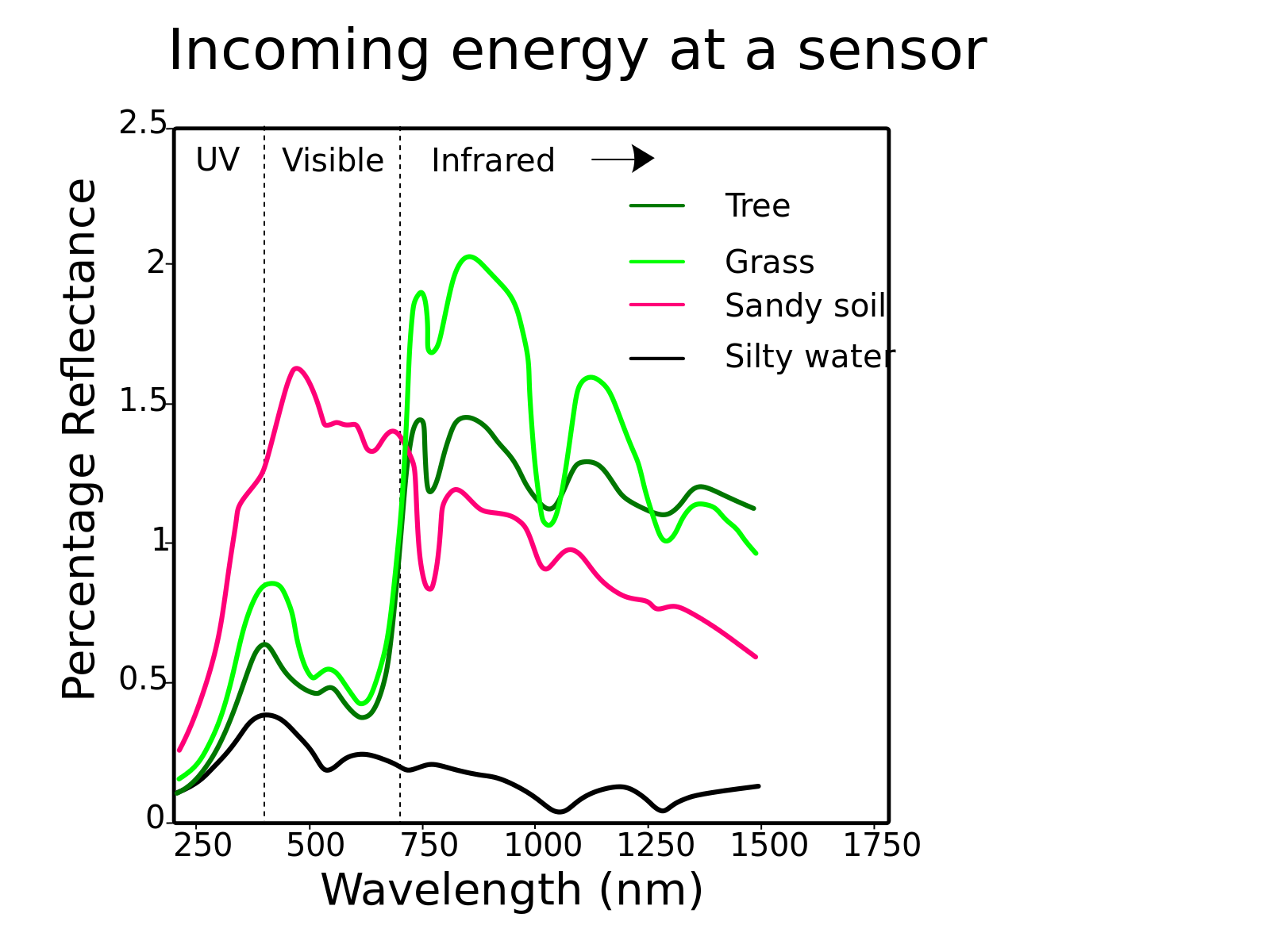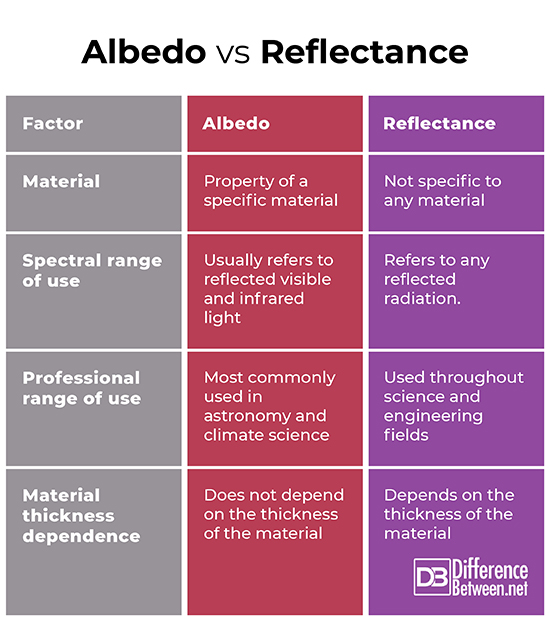Difference Between Albedo and Reflectance

Albedo
Albedo is a quantity that indicates how well a material reflects solar radiation. Albedo is measured as a decimal between 0 and 1. A value of 0 would indicate a perfect absorber that does not reflect any radiation. A value of 1 would indicate a material that reflected all radiation, or a perfect reflector.
What causes albedo?
Materials will differ in how much light they reflect based on their physical properties. As a result, they will also differ in albedo.
What is called albedo?
The term albedo is usually used specifically for reflected visible and infrared light. Furthermore, in astronomy, there are two types of albedos, normal albedo, and bond albedo. Normal albedo refers to the reflected light from a surface where the direction of illumination and the direction of viewpoint are both vertical. The bond albedo refers to the total fraction of solar radiation reflected back into space from a planetary surface.
What is an example of albedo?
Common examples of albedo include the ice-albedo feedback in climate science and the use of albedo to determine the size of astronomical objects.
Sea ice has a high albedo, about 0.5-0.7, and it can be as high as 0.85 if it is covered in fresh snow. As a result, large amounts of sea ice in the Arctic Ocean can keep the planet cooler than it would be otherwise. The open ocean has a much lower albedo, approximately 0.06. As a result, as sea ice melts, the amount of solar radiation being absorbed by the ocean surface will increase. This causes the ocean to become even warmer which causes even more ice to melt, creating a positive feedback loop. It is for this reason that the yearly reduction in total sea ice has a significant effect on the global climate.
Albedo is also used in astronomy to determine the approximate size of solar system bodies. Because asteroids tend to be small and distant, they usually only appear as points of light to astronomers. As a result, astronomers cannot measure their size directly. Astronomers will instead use the detectable brightness, along with the object’s albedo and distance from Earth, to estimate the object’s size.
Albedo can also be used to make rough maps of planetary surfaces. For example, large surface features on the dwarf planet Pluto, which were imaged by the New Horizons spacecraft in 2015, were initially observed as varying patches of high and low albedo on Pluto’s surface. Albedo also has the potential to be used in exoplanet research and could be used to detect clouds, weather, and even the signatures of continents and oceans on planets orbiting other stars.
What is the difference between albedo and emissivity?
Emissivity is the ratio of the radiation emitted by a material to the radiation emitted by a perfect emitter, or a blackbody. Emissivity and albedo are similar in that they both involve the radiation coming from an object. Emissivity is different, however, in that emissivity involves radiation that is emitted by the material, while albedo involves radiation that is reflected by the material.

Reflectance
What does reflectance mean?
Reflectance is the ratio of the reflected radiant flux of a surface to the incident radiant flux of a surface. In other words, it is the ratio of the radiation reflected by a surface to the total radiation absorbed, emitted, or reflected by that surface. Since reflectance is a ratio of fluxes, it is unitless.
What is the difference between reflectance and reflectivity?
Reflectivity is the property of a material that determines how much radiation it reflects. It is different from reflectance in that it does not depend on the thickness of the material. If a material is semi-infinitely thick and homogenous, the reflectivity and reflectance will be the same. If the material is thin, made of multiple layers, or both, the reflectivity and the reflectance will differ.
Examples of reflectance
Reflectance is used in soil science to determine the physical properties of soils, including particle size and moisture content. It is also important in astronomy since reflectance spectroscopy is the primary method of learning about the nature and composition of astronomical objects, such as planets and asteroids.
Similarities between albedo and reflectance
Albedo and reflectance both involve reflected radiation.
Differences between albedo and reflectance
Although the concepts are similar, there are also important differences. These differences include the following.
- Albedo is the property of a specific material, whereas reflectance is not specific to any material.
- Albedo is a term primarily used for visible and infrared light, whereas reflectance refers to any form of reflected radiation.
- Albedo is more often used in astronomy and climate science, whereas reflectance is of more general usage in science and engineering fields.
- Albedo does not depend directly on material thickness, whereas reflectance does depend on material thickness.
Albedo vs. reflectance

Summary
Albedo is a quantity indicating how well an object reflects radiation. It is measured with decimals between 0 and 1. A low albedo means a dark surface, whereas a high albedo means a bright surface. Albedo depends on the physical properties of a material, particularly its surface properties. The concept is used most often in climate science and astronomy. In climate science, it is important for determining how materials influence the climate by how much radiation they absorb or reflect. In astronomy, albedo is important for detecting faint objects, such as asteroids, mapping the surfaces of distant solar system objects, and potentially for exoplanet research. Albedo is different from emissivity in that albedo involves the radiation reflected from a surface, whereas emissivity involves the radiation emitted from a surface. Reflectance is the ratio between the reflected radiant flux and the incident radiant flux on a surface. Reflectance is distinguished from reflectivity in that reflectivity is the property of a specific material and is independent of material thickness, whereas reflectance is not specific to any material and depends on material thickness. Applications of reflectance include the use of reflectance to study soil properties in soil science and reflectance spectroscopy in astronomy. Reflectance and albedo are similar, but they differ in important ways. Albedo depends on the material composing a surface. The term Albedo also is usually used for reflected visible and infrared light. Furthermore, the term albedo is most often used in astronomy and climate science. Albedo also does not depend on the thickness of a material, but mainly on the surface properties of the material. Reflectance, on the other hand, does not depend on a specific material. Reflectance is a term used for all forms of reflected radiation. Reflectance is also more broadly used across science and engineering fields. Furthermore, reflectance depends on the thickness of the material in contrast to albedo and reflectivity.
- Difference Between Environmental Performance Index and Development - November 24, 2023
- Difference Between Environmental Intervention and Development - November 8, 2023
- Difference Between Eco Efficiency and Eco Effectiveness - September 18, 2023
Search DifferenceBetween.net :
Leave a Response
References :
[0]Braslavsky, S. E.. "Glossary of terms used in photochemistry, 3rd edition (IUPAC Recommendations 2006): " Pure and Applied Chemistry, vol. 79, no. 3, 2007, pp. 293-465. https://doi.org/10.1351/pac200779030293.
[1]Grover, Velma I. “Albedo.” Global Climate Watcher, https://www.climate-policy-watcher.org/global-climate-2/albedo.html. Accessed 10 Sept. 2021.
[2]Perkins, Sid. "Core Concept: Albedo is a simple concept that plays complicated roles in climate and astronomy." Proceedings of the National Academy of Sciences 116.51 (2019): 25369-25371. https://www.pnas.org/content/116/51/25369.
[3]Petrov, V.A. “Reflectivity.” Thermopedia, https://www.thermopedia.com/content/1082/. Accessed 10 Sept. 2021.
[4]Popescu, Marcel, et al. "Applications of Visibile and Infrared Spectroscopy to Astronomy." UPB Scientific Bulletin, Series A 3 (2012): 107-120. https://www.scientificbulletin.upb.ro/rev_docs_arhiva/full6ba_272194.pdf
[5]“Radiant Flux.” RP Photonics, n.d., https://www.rp-photonics.com/radiant_flux.html.
[6]“Radio Wave Reflection.” Electronicsnotes, n.d., https://www.electronics-notes.com/articles/antennas-propagation/propagation-overview/radio-em-wave-reflection.php.
[7]“Reflectance, Reflectivity, and the Solar Reflectance Index.” Electric 4 U, 11 Oct. 2020, https://www.electrical4u.com/what-is-reflectance/.
[8]“Thermodynamics: Albedo.” National Snow & Ice Data Center, 3 Apr. 2020, https://nsidc.org/cryosphere/seaice/processes/albedo.html.
[9]“What is emissivity and why is it important?” NPL, n.d., https://www.npl.co.uk/resources/q-a/why-is-emissivity-important.
[10]Image credit: https://commons.wikimedia.org/wiki/File:Ice_albedo_feedback.jpg
[11]Image credit: https://commons.wikimedia.org/wiki/File:Incoming_spectral_reflectance_from_different_objects_to_a_sensor_system.svg
